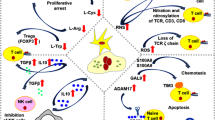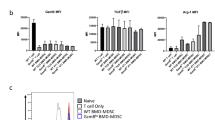Abstract
As more groups investigate the role of myeloid-derived suppressor cells (MDSCs) in promoting the growth of primary tumors and distant tumor metastases, it is imperative to ensure the accurate detection and quantification of MDSC immunosuppression ex vivo. MDSCs are defined by their ability to suppress immune responses. Although different in vitro culture conditions have been used to study MDSCs, the effect of different culture conditions on MDSC immunosuppression is unknown. We therefore isolated MDSCs from the lungs and spleens of 4T1 murine mammary tumor-bearing mice and assayed MDSC-mediated suppression of T cell responses under different culture conditions. We found that 4T1-induced MDSCs effectively suppressed T cell proliferation under serum-free conditions, but not when fetal calf serum (FCS) was present. FCS neither altered the immunosuppressive activities of other myeloid cell types (i.e., peritoneal or tumor-associated macrophages) nor modified the susceptibility of T cells to myeloid cell-mediated suppression, but instead acted directly on 4T1-induced MDSCs to significantly reduce their immunosuppressive function. Importantly, we found that bovine serum albumin was a major contributor to the antagonistic effects of FCS on 4T1-induced MDSC immunosuppression by inhibiting reactive oxygen species production from MDSCs. This work reveals that in vitro culture conditions influence the immunosuppressive properties of MDSCs and highlights the importance of testing different culture conditions on MDSC phenotype to ensure that MDSC immunosuppression is not being masked. These data have important implications for the accurate detection and identification of MDSCs, as well as for determining the influence of MDSC-mediated immunosuppression on primary and metastatic tumor growth.







Similar content being viewed by others
References
Teng MW, Swann JB, Koebel CM, Schreiber RD, Smyth MJ (2008) Immune-mediated dormancy: an equilibrium with cancer. J Leukoc Biol 84:988–993
Whiteside TL (2006) Immune suppression in cancer: effects on immune cells, mechanisms and future therapeutic intervention. Semin Cancer Biol 16:3–15
Hanahan D, Weinberg RA (2011) Hallmarks of cancer: the next generation. Cell 144:646–674
Biswas SK, Mantovani A (2010) Macrophage plasticity and interaction with lymphocyte subsets: cancer as a paradigm. Nat Immunol 11:889–896
Nagaraj S, Gabrilovich DI (2010) Myeloid-derived suppressor cells in human cancer. Cancer J 16:348–353
Youn JI, Gabrilovich DI (2010) The biology of myeloid-derived suppressor cells: the blessing and the curse of morphological and functional heterogeneity. Eur J Immunol 40:2969–2975
Priceman SJ, Sung JL, Shaposhnik Z, Burton JB, Torres-Collado AX, Moughon DL, Johnson M, Lusis AJ, Cohen DA, Iruela-Arispe ML, Wu L (2010) Targeting distinct tumor-infiltrating myeloid cells by inhibiting CSF-1 receptor: combating tumor evasion of antiangiogenic therapy. Blood 115:1461–1471
Yang L, DeBusk LM, Fukuda K, Fingleton B, Green-Jarvis B, Shyr Y, Matrisian LM, Carbone DP, Lin PC (2004) Expansion of myeloid immune suppressor Gr+CD11b+ cells in tumor-bearing host directly promotes tumor angiogenesis. Cancer Cell 6:409–421
Yang L, Huang J, Ren X, Gorska AE, Chytil A, Aakre M, Carbone DP, Matrisian LM, Richmond A, Lin PC, Moses HL (2008) Abrogation of TGF β signaling in mammary carcinomas recruits Gr-1+CD11b+ myeloid cells that promote metastasis. Cancer Cell 13:23–35
Sinha P, Clements VK, Ostrand-Rosenberg S (2005) Interleukin-13-regulated M2 macrophages in combination with myeloid suppressor cells block immune surveillance against metastasis. Cancer Res 65:11743–11751
Ostrand-Rosenberg S (2010) Myeloid-derived suppressor cells: more mechanisms for inhibiting antitumor immunity. Cancer Immunol Immunother 59:1593–1600
Kusmartsev S, Su Z, Heiser A, Dannull J, Eruslanov E, Kubler H, Yancey D, Dahm P, Vieweg J (2008) Reversal of myeloid cell-mediated immunosuppression in patients with metastatic renal cell carcinoma. Clin Cancer Res 14:8270–8278
Vieweg J, Su Z, Dahm P, Kusmartsev S (2007) Reversal of tumor-mediated immunosuppression. Clin Cancer Res 13:727s–732s
Zea AH, Rodriguez PC, Atkins MB, Hernandez C, Signoretti S, Zabaleta J, McDermott D, Quiceno D, Youmans A, O’Neill A, Mier J, Ochoa AC (2005) Arginase-producing myeloid suppressor cells in renal cell carcinoma patients: a mechanism of tumor evasion. Cancer Res 65:3044–3048
Ochoa AC, Zea AH, Hernandez C, Rodriguez PC (2007) Arginase, prostaglandins, and myeloid-derived suppressor cells in renal cell carcinoma. Clin Cancer Res 13:721s–726s
Young MR, Lathers DM (1999) Myeloid progenitor cells mediate immune suppression in patients with head and neck cancers. Int J Immunopharmacol 21:241–252
Mandruzzato S, Solito S, Falisi E, Francescato S, Chiarion-Sileni V, Mocellin S, Zanon A, Rossi CR, Nitti D, Bronte V, Zanovello P (2009) IL4Rα+ myeloid-derived suppressor cell expansion in cancer patients. J Immunol 182:6562–6568
Valenti R, Huber V, Filipazzi P, Pilla L, Sovena G, Villa A, Corbelli A, Fais S, Parmiani G, Rivoltini L (2006) Human tumor-released microvesicles promote the differentiation of myeloid cells with transforming growth factor-β-mediated suppressive activity on T lymphocytes. Cancer Res 66:9290–9298
Diaz-Montero CM, Salem ML, Nishimura MI, Garrett-Mayer E, Cole DJ, Montero AJ (2009) Increased circulating myeloid-derived suppressor cells correlate with clinical cancer stage, metastatic tumor burden, and doxorubicin-cyclophosphamide chemotherapy. Cancer Immunol Immunother 58:49–59
Youn JI, Nagaraj S, Collazo M, Gabrilovich DI (2008) Subsets of myeloid-derived suppressor cells in tumor-bearing mice. J Immunol 181:5791–5802
Rodriguez PC, Hernandez CP, Quiceno D, Dubinett SM, Zabaleta J, Ochoa JB, Gilbert J, Ochoa AC (2005) Arginase I in myeloid suppressor cells is induced by COX-2 in lung carcinoma. J Exp Med 202:931–939
Gallina G, Dolcetti L, Serafini P, De Santo C, Marigo I, Colombo MP, Basso G, Brombacher F, Borrello I, Zanovello P, Bicciato S, Bronte V (2006) Tumors induce a subset of inflammatory monocytes with immunosuppressive activity on CD8+ T cells. J Clin Invest 116:2777–2790
Habibi M, Kmieciak M, Graham L, Morales JK, Bear HD, Manjili MH (2009) Radiofrequency thermal ablation of breast tumors combined with intralesional administration of IL-7 and IL-15 augments anti-tumor immune responses and inhibits tumor development and metastasis. Breast Cancer Res Treat 114:423–431
Greenwald RJ, Freeman GJ, Sharpe AH (2005) The B7 family revisited. Annu Rev Immunol 23:515–548
Kryczek I, Zou L, Rodriguez P, Zhu G, Wei S, Mottram P, Brumlik M, Cheng P, Curiel T, Myers L, Lackner A, Alvarez X, Ochoa A, Chen L, Zou W (2006) B7-H4 expression identifies a novel suppressive macrophage population in human ovarian carcinoma. J Exp Med 203:871–881
Huang B, Pan PY, Li Q, Sato AI, Levy DE, Bromberg J, Divino CM, Chen SH (2006) Gr-1+CD115+ immature myeloid suppressor cells mediate the development of tumor-induced T regulatory cells and T-cell anergy in tumor-bearing host. Cancer Res 66:1123–1131
Aslakson CJ, Miller FR (1992) Selective events in the metastatic process defined by analysis of the sequential dissemination of subpopulations of a mouse mammary tumor. Cancer Res 52:1399–1405
Pulaski BA, Ostrand-Rosenberg S (2001) Mouse 4T1 breast tumor model. Curr Protoc Immunol Chap 20:Unit 20.2
Heppner GH, Miller FR, Shekhar PM (2000) Nontransgenic models of breast cancer. Breast Cancer Res 2:331–334
Sinha P, Clements VK, Ostrand-Rosenberg S (2005) Reduction of myeloid-derived suppressor cells and induction of M1 macrophages facilitate the rejection of established metastatic disease. J Immunol 174:636–645
Ko JS, Rayman P, Ireland J, Swaidani S, Li G, Bunting KD, Rini B, Finke JH, Cohen PA (2010) Direct and differential suppression of myeloid-derived suppressor cell subsets by sunitinib is compartmentally constrained. Cancer Res 70:3526–3536
Srivastava MK, Sinha P, Clements VK, Rodriguez P, Ostrand-Rosenberg S (2010) Myeloid-derived suppressor cells inhibit T-cell activation by depleting cystine and cysteine. Cancer Res 70:68–77
Murphy KM, Heimberger AB, Loh DY (1990) Induction by antigen of intrathymic apoptosis of CD4+CD8+TCRlo thymocytes in vivo. Science 250:1720–1723
Le HK, Graham L, Cha E, Morales JK, Manjili MH, Bear HD (2009) Gemcitabine directly inhibits myeloid derived suppressor cells in BALB/c mice bearing 4T1 mammary carcinoma and augments expansion of T cells from tumor-bearing mice. Int Immunopharmacol 9:900–909
Kodumudi KN, Woan K, Gilvary DL, Sahakian E, Wei S, Djeu JY (2010) A novel chemoimmunomodulating property of docetaxel: suppression of myeloid-derived suppressor cells in tumor bearers. Clin Cancer Res 16:4583–4594
Seifert CF, Resman-Targoff BH (2006) Clinical laboratory tests and interpretation. In: Helms RA, Quan DJ, Herfindal ET, Gourley DR (eds) Textbook of therapeutics: drug and disease management. Lippincott Williams & Wilkins, Philadelphia, pp 91–115
Monette FC, Sigounas G (1990) Some observations on the growth requirements of multi-potent stem cells under defined culture conditions. In: Dainiak N, Cronkite EP, McCaffrey R, Shadduck RK (eds) The biology of hematopoiesis. Wiley-Liss, Inc., New York, pp 37–48
Chen HW, Kandutsch AA (1981) Cholesterol requirements for cell growth: endogenous synthesis versus exogenous sources. In: Weymouth C, Ham RG, Chapple PJ (eds) The growth requirements of vertebrate cells in vitro. Cambridge University Press, New York, pp 327–342
Barnes D, Sato G (1980) Serum-free cell culture: a unifying approach. Cell 22:649–655
Dainiak N (1985) Role of defined and undefined serum additives to hematopoietic stem cell culture. In: Cronkite EP, Dainiak N, McCaffrey RP, Palek J, Quesenberry PJ (eds) Hematopoietic stem cell physiology. Alan R. Liss, New York, pp 59–76
Sinha P, Okoro C, Foell D, Freeze HH, Ostrand-Rosenberg S, Srikrishna G (2008) Proinflammatory S100 proteins regulate the accumulation of myeloid-derived suppressor cells. J Immunol 181:4666–4675
Haverkamp JM, Crist SA, Elzey BD, Cimen C, Ratliff TL (2011) In vivo suppressive function of myeloid-derived suppressor cells is limited to the inflammatory site. Eur J Immunol 41:749–759
Nausch N, Galani IE, Schlecker E, Cerwenka A (2008) Mononuclear myeloid-derived “suppressor” cells express RAE-1 and activate natural killer cells. Blood 112:4080–4089
Acknowledgments
The authors would like to thank Jessica Jia for helpful discussions and Christine Kelly for assistance preparing the manuscript. This work was supported by the Canadian Cancer Society Research Institute with funds from the Terry Fox Foundation (K. L. B. grant #020395 and G. K. grant #018006). Core support was provided by the BC Cancer Foundation and the BC Cancer Agency. M. J. H. was supported by a Michael Smith Foundation for Health Research Trainee Award and a Canadian Institutes of Health Research Studentship. K. L. B. is a Michael Smith Foundation for Health Research Scholar.
Author information
Authors and Affiliations
Corresponding author
Rights and permissions
About this article
Cite this article
Hamilton, M.J., Banáth, J.P., Lam, V. et al. Serum inhibits the immunosuppressive function of myeloid-derived suppressor cells isolated from 4T1 tumor-bearing mice. Cancer Immunol Immunother 61, 643–654 (2012). https://doi.org/10.1007/s00262-011-1125-0
Received:
Accepted:
Published:
Issue Date:
DOI: https://doi.org/10.1007/s00262-011-1125-0




